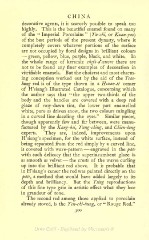Page 370 - Oriental Series Japan and China, Brinkly
P. 370
CHINA
decorative agents, it is scarcely possible to speak too
highly. This is the beautiful enamel found on many
"
of the Imperial Porcelains" (Tu-chi, or Kuan-yao}
of the best periods of the present dynasty, where it
completely covers whatever portions of the surface
are not occupied by floral designs in brilliant colours
green, yellow, blue, purple, black, and white. In
the whole range of keramic chefs-d'ceuvre there are
not to be found any finer examples of decoration in
vitrifiable enamels. But the choicest and most charm-
ing conception worked out by the aid of the Tsao-
hung red is of the type shown in a Hsuan-te censer
of H'siang's Illustrated Catalogue, concerning which
the author says that " the upper two-thirds of the
body and the handles are covered with a deep red
glaze of rosy-dawn tint, the lower part enamelled
white, pure as driven snow, the two colours mingling
in a curved line dazzling the eyes." Similar pieces,
though apparently few and far between, were manu-
factured by the Katig-Ast, Tung-ching, and Chien-lung
experts. They are, indeed, improvements upon
H'siang's specimen, for the white surface, instead of
being separated from the red simply by a curved line,
is covered with wave-pattern engraved in the pate
with such delicacy that the superincumbent glaze is
as smooth as velvet the crests of the waves curling
up into the brilliant red above. It is probable that
in H'siang's censer the red was painted directly on the
pdte, a method that would have added largely to its
depth and brilliancy. But the Tsing reproductions
of this fine type gain in artistic effect what they lose
in grandeur of tone.
The second red among those applied to porcelain
"
already stoved, is the Ten-chi-hung, or Red."
Rouge
300

